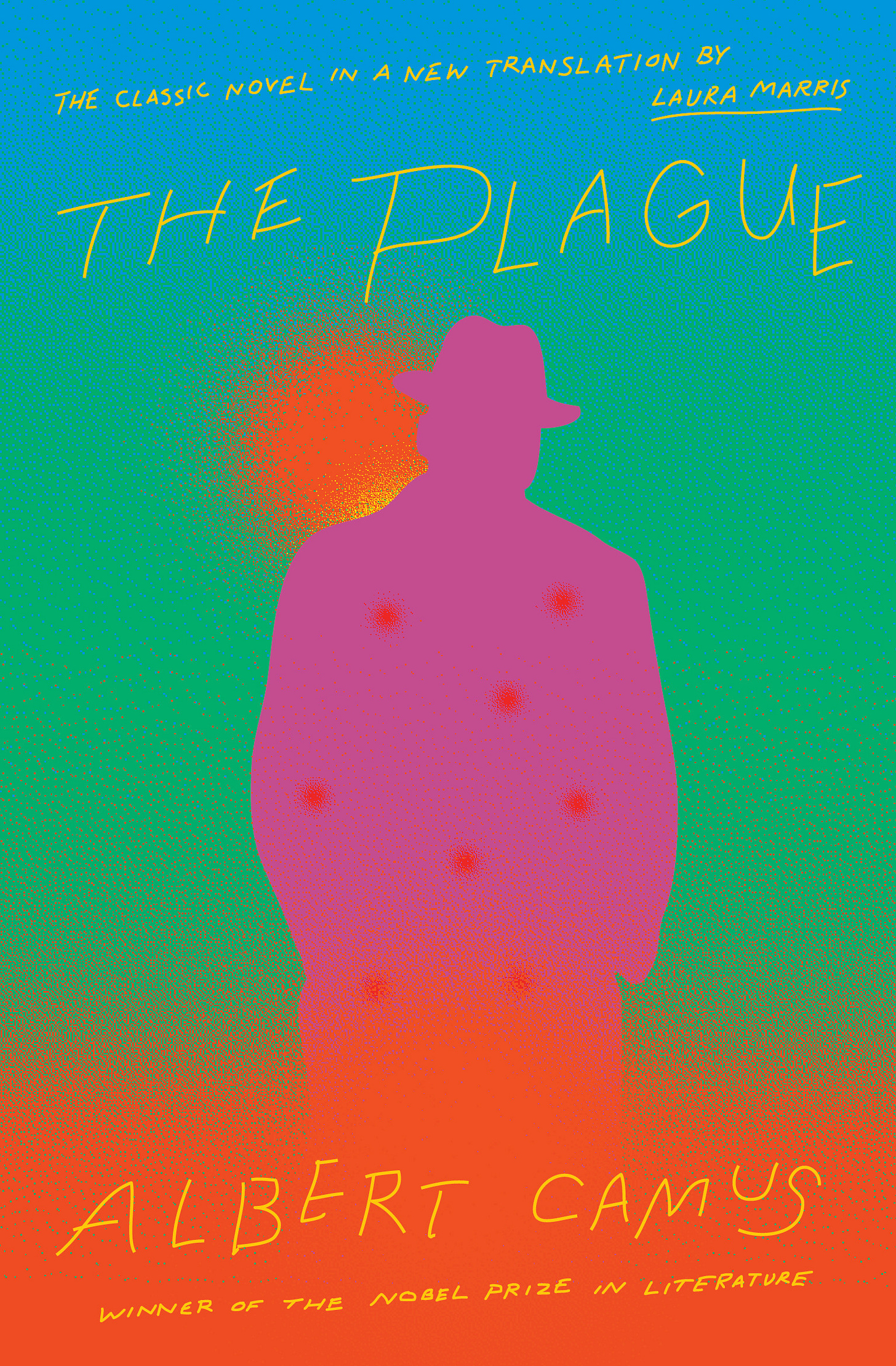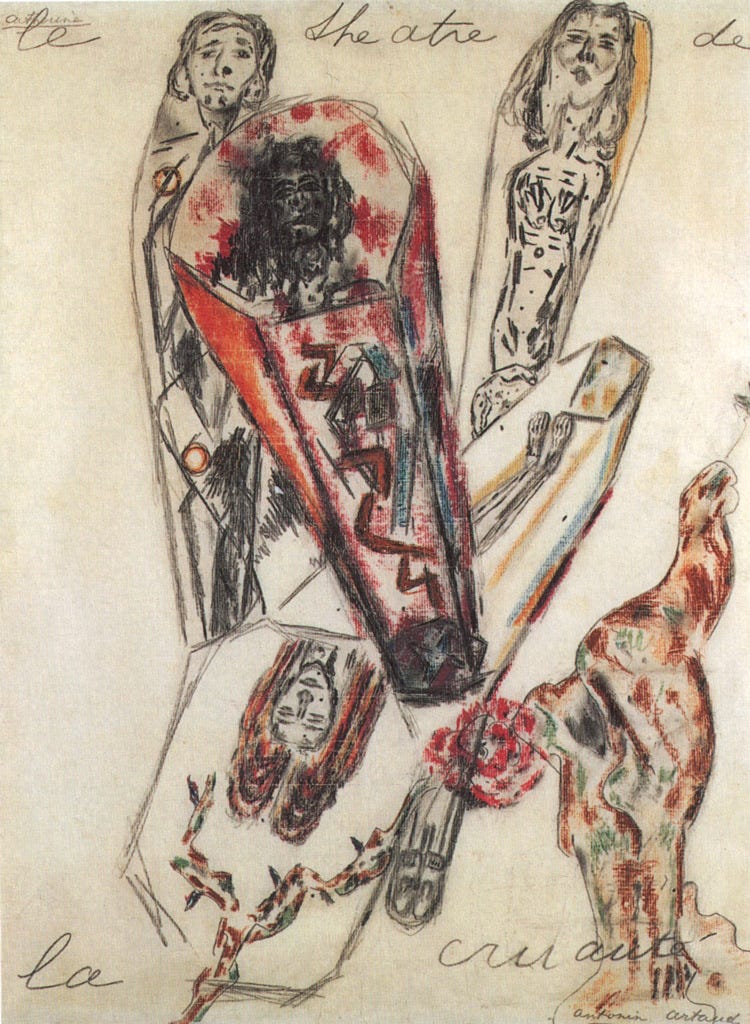1.
In 1941, one month after finishing the writing of The Myth of Sisyphus, Camus made the following note: ‘On Oran. Write an insignificant and absurd biography.’ He was at that time living in Oran, on the Algerian coast, with his wife Francine Faure and her family. In 1939, when Francine was still his fiancé, Camus had made frequent visits to Oran. He was at the time still living in the town of his birth, Algiers, where his family still lived. Later that year, after the war had already begun, he wrote a lyrical essay about Oran, called “The Minotaur; or The Stop in Oran”. Here Camus described the built environment of the town, as if it were a labyrinth, with the Minotaur at its centre signifying the town’s pervasive mood: boredom. It was from this material, and the idea of writing ‘an insignificant and absurd biography’ of Oran that soon suggested the setting for The Plague.
In April 1941 – two months after finishing Sisyphus – Camus and Francine were visited in Oran by friends from nearby Turenne. There was currently an outbreak of typhus in the region, which had led to strict quarantine measures being imposed. The previous year there was approximately 2,100 reported cases of typhus fever in Algeria. By the end of 1941 there would be closer to 13,000. That figure would peak the following year with approximately 35,000 reported cases of typhus. Camus’ friends had been medically cleared to travel, and during their visit to Oran Camus peppered them with questions about the situation, the administrative, military, and medical procedures, and the effect of these measures on the behaviour of the townsfolk. That same month, in his notebook, under the heading: ‘the world of tragedy and the spirit of revolt’, Camus wrote: ‘Plague or adventure (novel).’
2.
There is, however, some reason to believe Camus was already considering the plague metaphor before this event, and this visit from his friends was merely fortuitous. During the late 1930s in Algiers, Camus directed two theatre companies, writing, directing, and acting in several original plays as well as adaptations. He was aware of the ideas of Antonin Artaud, particularly his influential essay, “The Theatre and the Plague”, which first appeared in an edition of Nouvelle Revue Française in October 1934 and again in Artaud’s 1938 collection of essays, The Theater and Its Double. Camus’ friend and teacher, Jean Grenier, had worked for the Gallimard publishing house – which published the NRF – prior to coming to Algiers in 1930. Grenier knew, and also wrote for, the editors of Nouvelle Revue Française throughout the 1930s, and he introduced the young Camus to the magazine soon after they became acquainted. In 1934 Camus was working with friends in Algeria on putting together their own journal, to be called La Nouvelle Journée, and Camus’ task was to survey current cultural journals from France, which included Nouvelle Revue Française. This was the same year that Artaud’s essay appears in that journal.
“The Theatre and the Plague” includes a literary and historical overview of plague, as well as detailed medical descriptions of its effect on the human body. Artaud argues that the plague affects the brain and the lungs of its victims, much like theatre infects the actors in the same organs, grounding their bodies to the stage, and their voices to their breath. Like plague, theatre is also contagious and this contagion extends to incorporate the audience in the spectacle produced. For Artaud, the plague, like theatre, had a cathartic and liberatory function. ‘Like the plague,’ Artaud wrote, ‘theatre is collectively made to drain abscesses.’
Camus was also familiar with Artaud’s 1932 “Manifesto of the Theatre of Cruelty” (1932), which was also included, along with an additional essay, “The Theatre of Cruelty”, in Artaud’s The Theatre and Its Double. Camus referenced this notion of cruelty in his own manifesto for one of his own theatre companies in the late 1930s. The ideas of cruelty and plague also underwrote Camus’ play, Caligula, based on the madness of this Roman emperor. This is the play that Camus completed (a first version of) in 1939, as part of his first cycle of works, accompanying The Stranger and The Myth of Sisyphus. The second version, which was then performed, was completed in 1945. As Caligula declaims in Act IV:
“Until now my reign has been too happy. There’s been no world-wide plague, no religious persecution, not even a rebellion – nothing in fact to make us memorable. And that, I’d have you know, is why I try to remedy the stinginess of Fate. I mean – I don’t know if you’ve followed me – that, well [he gives a little laugh], it’s I who replace the epidemics that we’ve missed.”
The image of the plague can also be found in The Myth of Sisyphus, where Camus writes: ‘The last Carrara, a prisoner in Padua emptied by the plague and besieged by the Venetians, ran screaming through the halls of his deserted palace: he was calling on the devil and asking him for death. This was a way of overcoming it.’ Significantly, this was in the section of the essay concerned with the Conqueror, a figure which prefigures the theme of rebellion which would constitute the second cycle of Camus’ work. Here the seeds of this theme are already presented within the context of plague.
3.
So by 1941 Camus had his setting, and his guiding metaphor, and then, in the very next notebook entry – under the heading: ‘The liberating plague’ – Camus began to sketch an initial outline for his new novel on rebellion. Adapting his earlier ideas of diversity and freedom to this new project, Camus outlined a number of individual characters, with each responding to the same situation in different ways. One of these characters would keep a diary of ‘insignificant events’, through which Camus would introduce material from his own notebooks, from 1938 onwards. A central figure that emerged early on was a classics teacher – later named Philippe Stephen – who would come to realise he never understood Thucydides and Lucretius until that moment of living through an actual plague. Prior to this, Stephen had been reading and teaching these ancient works too abstractly.
At the same time, Camus was also working as a teacher in Oran, in both a private school, as well as a private tutor. The Vichy regime had imposed regulations – extended to French Algeria – which banned Jewish students from state run schools. It was some of these Jewish students in Oran that Camus taught privately during this period. Later that year, when he researched past plagues – the Black Death in 1342 and Spain in 1481 – Camus noted how historically such epidemics had been blamed on the Jews.
These same regulations that had banned Jewish students from French schools also placed restrictions on publishing in France. Camus’ publisher in Paris, Gallimard, which had accepted The Stranger and The Myth of Sisyphus for publication, were ordered by the Nazi censors to excise the section abut Kafka in the essay, because he was a Jewish writer. That section was published separately in the (then) free-zone of mainland France, and was replaced in the book by a text on Dostoevsky.
This section on Dostoevsky wasn’t the only late insertion into The Myth of Sisyphus. In 1941, Gallimard had released a French translation of Herman Melville’s Moby Dick. Camus devoured the novel. In Sisyphus, Camus had proposed a theory of fiction that would reflect, and remain consistent with, his personal ethic of absurdity and revolt. In a late footnote added to the proofs of Sisyphus, prior to publication, he indicated that Melville’s Moby Dick was precisely the type of fiction he had in mind. What drew Camus to this novel in particular was that it was a symbolic work, and he read it at a time when he was beginning his own symbolic work. In his notebooks, in late 1941 or early 1942, he even went as far as to list page numbers from his copy of Moby Dick where Melville deployed symbols in ways Camus felt most instructive to his own project. Reading Melville helped Camus consider the metaphoric possibilities of his own developing plague symbol.
Melville’s novel also provided an additional narrative framework for Camus: the encyclopaedic chapters on whaling, which interspersed the main chapters of the novel. The first draft of The Plague written in 1941-1942 proposed a fictional archive of public and private documents marking the course of the epidemic: newspaper reports, government papers and orders, private letters, diary entries, and telegrams. These were going to break up the chapters of the novel that were otherwise focused on individual characters and their actions. Later, however, this idea was abandoned, but much of this material was kept, embedded within the main narrative, or else used as deep background.
In the meantime, circumstances would soon force additional ideas upon Camus and further complicate his developing plague symbol.

